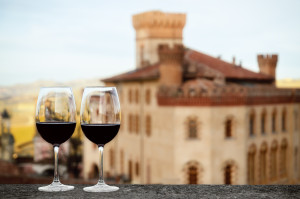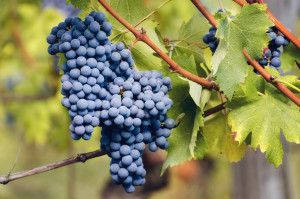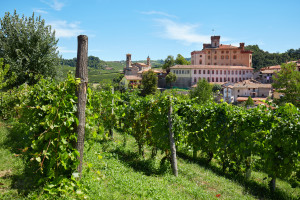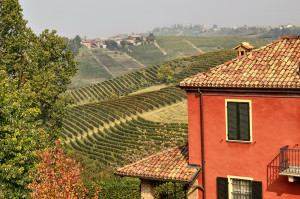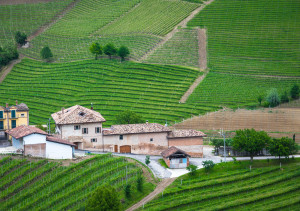Today we have a conference preview from Alan Tardi. In this post, Alan tells us about his upcoming session on Nebbiolo-based wines entitled “Noble Nebbiolo.” He even gives us a sneak peak at the amazing wines that will be served. Alan’s session is offered as part SWE’s 43rd Annual Conference, to be held August 14 – 16 in Washington DC.
In Vino Nobils?
While it is often challenging to articulate wine in words, the term ‘noble’ is a particularly loaded one, partly because it is used in so many different contexts.
To begin with, there are categoric uses of the word. “Noble Grapes” refers to a group of varieties that have achieved prominence throughout the world, but membership in this elite group is somewhat subjective, ranging from six—Chardonnay, Sauvignon Blanc, Riesling, Cabernet Sauvignon, Pinot Noir and Merlot—to 18 or more. What’s more, it is unclear who first created this group or why the most popular, most adaptable, most widely dispersed, commercially viable and therefore most common grape varieties of all should qualify them as noble.
In Alsace, noble status has been officially conferred on four specific varieties: Riesling, Gewürztraminer, Pinot Gris and Muscat. Only these grapes can be used for Grand Cru or Sélections de Grains Nobles categories, while a wine labeled Gentil must be made up of at least 50% of them.
There are also literal associations. The phrase “King of wines and wine of Kings” has been applied to a number of wines throughout history (Barolo and Champagne, for example) both because members of the nobility took a particular liking to them and because they were produced on estates belonging to members of the noble class. At the end of his dithyrambic poem “Bacco in Toscana” published in 1685, author Francesco Rambi declares “Montepulciano is the King of all wines!” after which it became known as Vino Nobile di Montepulciano. And Louis the XV, King of France, is said to have offered his official chief mistress Madame Pompadour a glass of Tokaji calling it “Vinum Regum, Rex Vinorum” (Wine of Kings and King of Wines).
Finally, the term is often used in a descriptive sense. Wine writers and tasters sometimes use noble as an adjective to describe the character of a grape variety or a wine made from it, as I am doing by calling my session at the 43rd annual conference of the Society of Wine Educators “Noble Nebbiolo.”
But what does it actually mean? Or, to put it another way, what are the characteristics of a grape variety or the wine made from it that could justifiably be described as noble?
Before going any further, let me clarify that my session will focus on one grape variety, Nebbiolo, and feature wines in a range of typologies from the principal appellations and diverse terroirs of the three regions of northern Italy—Piemonte, Lombardia and Valle d’Aosta—that constitute its traditional home.
Just as noble people, actions or sentiments are not all the same, it is perfectly reasonable to expect that a given grape variety would express its inherent noble qualities in different ways, and that even members of the same clan or dynasty (or grape variety, in this case) would over time develop different characteristics based on the location of their domain.
So, what basic “noble” characteristics can be attributed to the Nebbiolo grapevine itself? It is a late-ripening grape which means that it often reaches maturity in mid- to late fall, long after most others have been harvested, when the days get short, the nights get cold and fog (‘nebbia’ in Italian) covers the vineyards, all of which one might say contributes austerity, restraint and a haughty aloofness to its regal character. Winegrowers must often wait with patient deference for the grapes to ripen and for a slow fermentation to run its course, and consumers must often wait for Nebbiolo-based wines to open up and show what they really have to offer.
Nebbiolo-based wines generally have pronounced natural tannin, notable acidity, a pale transparent color, and a surprising capacity to age and develop over time, acquiring layers of complexity as it matures.
Sometimes (as participants will see during the class) grapes from young vines or less favorable sites can be harvested a bit early to retain their crisp acidity and tart fruit and be made into a rosato or sparkling wine. In such cases the ‘noble’ lineage of the grape takes the shape of a frolicking prince or princess. But the most noble expressions of Nebbiolo tend to come from older vines harvested at peak maturity in exceptional vineyard sites with low yields, slow long fermentation and extended aging.
Finally, and contrary to membership requirements of the Noble Grapes Club, Nebbiolo is extremely selective about where it will sink its roots and reign. With the exception of some sporadic New World experiments and one isolated southern outpost, Nebbiolo grows only in specific areas of northern Italy. And this high degree of selectivity about where it will (and will not) grow seems to suggest a sort of noble birthright. But wherever it does grow, Nebbiolo demonstrates an astounding ability to express nuances of the particular environment and a particular growing season, and then transfer these factors into the wines it produces, which most always occupies top billing on the roster of wines in that area. In this sense, Nebbiolo wines are truly a noble representative of the place that they come from.
Of course, when it comes to wine, we can talk about it all we like, but the best spokesperson for a grape variety are the wines that are made from it. In order to ‘hear’ what they have to say you need to taste them. And that is precisely what we will do in this “Noble Nebbiolo” session.
We have a stellar lineup of 100% Nebbiolo wines in a variety of typologies (traditional method sparkling, rosato, appassimento) from all of the principal growing areas and appellations including Lombardia (Valtellina), Valle d’Aosta (Donnas), Alto Piemonte (Ghemme, Gattinara, Carema), Langhe (Barolo) and Roero.
While exploring these extremely diverse expressions of Nebbiolo based on growing area, vintage and winemaking practice, we will also look for common threads—for the fundamental inherent character of the grapevine—that run between them. And at the end we may even try to determine whether, in fact, the descriptor “noble” is an appropriate one.
You can’t have a wine tasting without wines, so here’s a big shout out of gratitude to the great producers and importers that made these exceptional examples of Nebbiolo available for my presentation at the Society of Wine Educators conference 2019:
Wineries:
- Antoniolo
- ArPePe
- Erpacrife
- Mamete Prevostini
- Cantalupo
- Cantina dei Produttori di Carema
- Caves de Donnas
- Tenuta Carretta
Importers:
Alan’s session, “Noble Nebbiolo” will be held on Friday, August 16 at 1:15 pm as part of the Society of Wine Educator’s 43rd Annual Conference, to be held in Washington DC.
Are you a conference speaker that would like to share a preview of your session? Contact Jane A. Nickles at jnickles@societyofwineeducators.org
